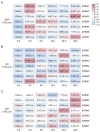Genome-Wide Identification and Expression Analysis of the Fructose-1,6-Bisphosphate Aldolase (FBA) Gene Family in Sweet Potato and Its Two Diploid Relatives
- PMID: 40806478
- PMCID: PMC12347426
- DOI: 10.3390/ijms26157348
Genome-Wide Identification and Expression Analysis of the Fructose-1,6-Bisphosphate Aldolase (FBA) Gene Family in Sweet Potato and Its Two Diploid Relatives
Abstract
Fructose-1,6-bisphosphate aldolase (FBA; EC 4.1.2.13) is a key enzyme in glycolysis and the Calvin cycle, which plays crucial roles in carbon allocation and plant growth. The FBA family genes (FBA s) have been identified in several plants. However, their presence and roles in sweet potato remain unexplored. In this study, a total of 20 FBAs were identified in sweet potato and its wild wild diploidrelatives, including seven in sweet potato (Ipomoea batatas, 2n = 6x = 90), seven in I. trifida (2n = 2x = 30), and six in I. triloba (2n = 2x = 30). Their protein physicochemical properties, chromosomal localization, phylogenetic relationship, gene structure, promoter cis-elements, and expression patterns were systematically analyzed. The conserved genes and protein structures suggest a high degree of functional conservation among FBA genes. IbFBAs may participate in storage root development and starch biosynthesis, especially IbFBA1 and IbFBA6, which warrant further investigation as candidate genes. Additionally, the FBAs could respond to drought and salt stress. They are also implicated in hormone crosstalk, particularly with ABA and GA. This work provides valuable insights into the structure and function of FBAs and identifies candidate genes for improving yield, starch content, and abiotic stress tolerance in sweet potatoes.
Keywords: Fructose-1,6-bisphosphate aldolase; Ipomoea trifida; Ipomoea triloba; abiotic stress; hormone crosstalk; starch biosynthesis; storage root development; sweet potato.
Conflict of interest statement
The authors declare no conflicts of interest.
Figures









Similar articles
-
Genome-wide identification and expression analysis of the KNOX family and its diverse roles in response to growth and abiotic tolerance in sweet potato and its two diploid relatives.BMC Genomics. 2024 Jun 6;25(1):572. doi: 10.1186/s12864-024-10470-4. BMC Genomics. 2024. PMID: 38844832 Free PMC article.
-
Genome-Wide Identification and Expression Analysis of the Sucrose Synthase Gene Family in Sweet Potato and Its Two Diploid Relatives.Int J Mol Sci. 2023 Aug 6;24(15):12493. doi: 10.3390/ijms241512493. Int J Mol Sci. 2023. PMID: 37569874 Free PMC article.
-
Genome-wide identification of GATA family genes in sweet potato (Ipomoea batatas L.) and their expression patterns under abiotic stress.Front Genet. 2025 Jul 9;16:1635749. doi: 10.3389/fgene.2025.1635749. eCollection 2025. Front Genet. 2025. PMID: 40772271 Free PMC article.
-
Genome-wide characterization, evolution, and expression profiling of FBA gene family in response to light treatments and abiotic stress in Nicotiana tabacum.Plant Signal Behav. 2021 Oct 3;16(10):1938442. doi: 10.1080/15592324.2021.1938442. Epub 2021 Jun 12. Plant Signal Behav. 2021. PMID: 34120568 Free PMC article.
-
Genome-Wide Identification and Characterization of CDPK Family Reveal Their Involvements in Growth and Development and Abiotic Stress in Sweet Potato and Its Two Diploid Relatives.Int J Mol Sci. 2022 Mar 13;23(6):3088. doi: 10.3390/ijms23063088. Int J Mol Sci. 2022. PMID: 35328509 Free PMC article.
References
-
- Li Q., Zhao H., Jin Y.L., Zhu J.C., Ma D.F. Analysis and perspectives of sweetpotato industry contributing to national food security in China. J. Jiangsu Agric. Sci. 2022;38:1484–1491.
MeSH terms
Substances
Grants and funding
LinkOut - more resources
Full Text Sources

